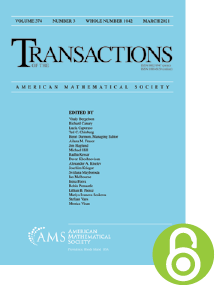Free interpolation by nonvanishing analytic functions
HTML articles powered by AMS MathViewer
- by Konstantin Dyakonov and Artur Nicolau PDF
- Trans. Amer. Math. Soc. 359 (2007), 4449-4465 Request permission
Abstract:
We are concerned with interpolation problems in $H^\infty$ where the values prescribed and the function to be found are both zero-free. More precisely, given a sequence $\{z_j\}$ in the unit disk, we ask whether there exists a nontrivial minorant $\{\varepsilon _j\}$ (i.e., a sequence of positive numbers bounded by 1 and tending to $0$) such that every interpolation problem $f(z_j)=a_j$ has a nonvanishing solution $f\in H^\infty$ whenever $1\ge |a_j|\ge \varepsilon _j$ for all $j$. The sequences $\{z_j\}$ with this property are completely characterized. Namely, we identify them as “thin” sequences, a class that arose earlier in Wolff’s work on free interpolation in $H^\infty \cap \operatorname {VMO}$.References
- L. Carleson and J. B. Garnett, Interpolating sequences and separation properties, J. Anal. Math. 28 (1975), 273–299.
- Konstantin M. Dyakonov, Moment problems for bounded functions, Comm. Anal. Geom. 2 (1994), no. 4, 533–562. MR 1336894, DOI 10.4310/CAG.1994.v2.n4.a2
- J. P. Earl, On the interpolation of bounded sequences by bounded functions, J. London Math. Soc. (2) 2 (1970), 544–548. MR 284588, DOI 10.1112/jlms/2.Part_{3}.544
- John B. Garnett, Bounded analytic functions, Pure and Applied Mathematics, vol. 96, Academic Press, Inc. [Harcourt Brace Jovanovich, Publishers], New York-London, 1981. MR 628971
- Pamela Gorkin and Raymond Mortini, Asymptotic interpolating sequences in uniform algebras, J. London Math. Soc. (2) 67 (2003), no. 2, 481–498. MR 1956148, DOI 10.1112/S0024610702004039
- Andreas Hartmann, Xavier Massaneda, Artur Nicolau, and Pascal Thomas, Interpolation in the Nevanlinna and Smirnov classes and harmonic majorants, J. Funct. Anal. 217 (2004), no. 1, 1–37. MR 2097605, DOI 10.1016/j.jfa.2004.02.015
- Peter W. Jones, Estimates for the corona problem, J. Functional Analysis 39 (1980), no. 2, 162–181. MR 597809, DOI 10.1016/0022-1236(80)90011-7
- Paul Koosis, Carleson’s interpolation theorem deduced from a result of Pick, Complex analysis, operators, and related topics, Oper. Theory Adv. Appl., vol. 113, Birkhäuser, Basel, 2000, pp. 151–162. MR 1771759
- Artur Nicolau, Interpolating Blaschke products solving Pick-Nevanlinna problems, J. Anal. Math. 62 (1994), 199–224. MR 1269205, DOI 10.1007/BF02835954
- Carl Sundberg and Thomas H. Wolff, Interpolating sequences for $QA_{B}$, Trans. Amer. Math. Soc. 276 (1983), no. 2, 551–581. MR 688962, DOI 10.1090/S0002-9947-1983-0688962-3
- T. Wolff, Some theorems on vanishing mean oscillation, Thesis, Univ. of California, Berkeley, California, 1979.
Additional Information
- Konstantin Dyakonov
- Affiliation: ICREA and Departament de Matemàtica Aplicada i Anàlisi, Universitat de Barcelona, Gran Via 585, E-08007 Barcelona, Spain
- Email: dyakonov@mat.ub.es
- Artur Nicolau
- Affiliation: Departament de Matemàtiques, Universitat Autònoma de Barcelona, E-08193 Bellaterra (Barcelona), Spain
- Email: artur@mat.uab.es
- Received by editor(s): October 11, 2004
- Received by editor(s) in revised form: October 1, 2005
- Published electronically: March 20, 2007
- Additional Notes: Both authors were supported by the European Community’s Human Potential Program under contract HPRN-CT-2000-00116 (Analysis and Operators). The first author was also supported by DGICYT Grant MTM2005-08984-C02-02, CIRIT Grant 2005-SGR-00611, Grant 02-01-00267 from the Russian Foundation for Fundamental Research, and by the Ramón y Cajal program (Spain). The second author was supported by DGICYT Grant MTM2005-00544 and CIRIT Grant 2005-SGR-00774.
- © Copyright 2007 American Mathematical Society
- Journal: Trans. Amer. Math. Soc. 359 (2007), 4449-4465
- MSC (2000): Primary 46J15, 30D50, 30H05
- DOI: https://doi.org/10.1090/S0002-9947-07-04186-4
- MathSciNet review: 2309193


